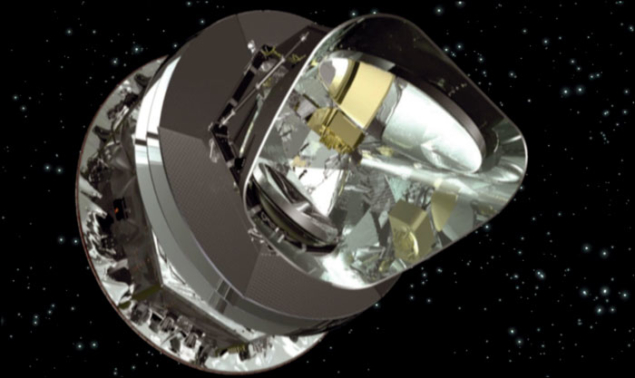
Image credit: ESA and the Planck collaboration.
The long awaited results from ESA’s Planck mission, based on the most detailed observations to date of the cosmic microwave background (CMB), were released on 21 March. While the new data confirm to high precision the standard model of cosmology, the detection of several anomalies could be hints of new physics to be understood.
ESA’s Planck and Herschel missions were launched simultaneously by an Ariane 5 rocket on 14 May 2009 (CERN Courier July/August 2009 p6). Since then, Planck has been scanning the whole sky every six months. After the results on galactic and extragalactic foregrounds (CERN Courier April 2012 p15), the Planck collaboration has now released the CMB results, the prime scientific objective of the mission. The collaboration issued almost 30 publications simultaneously, together with the data from the first half of the mission (15.5 months).
The CMB is a snapshot of the universe when it was 380,000 years old. At that time, the young universe was filled with a hot, dense medium of interacting protons, electrons and photons at about 2700° C. When the protons and electrons combined to form hydrogen atoms, radiation was set free. As the universe expanded, this radiation was stretched to microwave wavelengths, today equivalent to a temperature of just 2.7° C above absolute zero. The CMB is extremely uniform all over the sky. There are only tiny temperature fluctuations (at a level of 10–5) that correspond to regions of slightly different densities at very early times. Gravity will have acted to increase these fluctuations to form the galaxies and galaxy clusters that are seen today.
The fluctuations are of different amplitude on different angular scales. This is described by the power spectrum derived from the all-sky map of the CMB. The observed shape of the power spectrum can then be fitted by a model curve, whose shape is controlled by a set of cosmological parameters. There are only six free parameters for the standard model of a flat universe with cold dark matter and a cosmological constant, ΛCDM. Possible deviations from a pure ΛCDM cosmology can be tested by freeing additional parameters of the model. All attempts to search for deviations in the Planck data have proved insignificant. The main result of Planck is thus a remarkable confirmation of the standard ΛCDM model of the universe.

Image credit: ESA/Image by AOES Medialab.
Compared with NASA’s Wilkinson Microwave Anisotropy Probe (WMAP) satellite, Planck has a much higher sensitivity, a smaller angular scale and a larger spectral coverage, with nine bands instead of five. Yet despite this, Planck has not been able to change fundamentally the view of the cosmos as derived by WMAP (CERN Courier May 2006 p12, May 2008 p8). The updated energy-density content of the present universe consists of slightly higher fractions of ordinary, baryonic matter (4.9% instead of 4.5%) and of dark matter (26.8% instead of 22.7%), compensated by a decrease in the fraction of dark energy (68.3% instead of 72.8%). Planck has also confirmed the existence of some large-scale anomalies seen by WMAP, such as a lack of power in fluctuations at large angular scales, a small asymmetry on both sides of the ecliptic plane and the WMAP cold spot (CERN Courier October 2007 p13). Planck shows that these anomalies are, indeed, of cosmic origin but they are at a level still marginally compatible (2–3σ) with statistical variations on the sky.
The main highlights of the Planck results are constraints on the number and mass of relativistic neutrinos (Neff = 3.30±0.27 and Σmν < 0.66 eV),>NL = 2.7±5.8) and constraints on inflation models (ns = 0.96±0.01 and r < 0.11>8 = 0.82±0.02) and from galaxy clusters (σ8 = 0.77±0.02). Possibly the most unexpected result is a precise determination of the famous Hubble constant, which describes the rate of expansion of the universe, at a significantly lower value (H0 = 67.9±1.5 km/s/Mpc) than derived by other means. This was one of the prime objectives of the Hubble Space Telescope; now it is Planck that makes the most precise determination so far. The next milestone for Planck will be in 2014 with the release of the final products for the complete mission, including the polarization measurements. There is still potential for more exotic discoveries.








